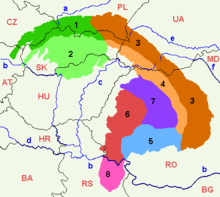Subcarpathian
The Subcarpathian region lies on the outer side of the Carpathian Arc . Austria , the Czech Republic , Poland , Slovakia , the Ukraine and Romania have a share in the Carpathian foothills . Geologically and geographically, at least the northern (outer) Vienna Basin is part of the Alpine and Carpathian foothills, it has a mediating position between the foothills of the mountains that have developed together. The geologically similarly young subsidence area in the interior of the Carpathian Arc is the Pannonian Plain , which occupies large parts of Hungary and Romania; it is not referred to as the Subcarpathian region.
geography
In Austria, the Subcarpathian region includes the western Weinviertel as far as the cliff zone . It is a flat to medium mountainous hill country with mighty loess covers . To the north of the Danube, a zone of sandstone mountains borders the Subcarpathian Mountains (example: Bisamberg ) as a continuation of the flysch zone of the Eastern Alps . Limestone cliffs to the south move towards the north-northeast and already belong to the Carpathian Mountains , for example the Leiser Berge (491 m), the Staatzer Klippe and the Falkensteiner Berge ( cliff zone / Waschberg zone ). Only in the Outer Vienna Basin does Slovakia have a share of the Sub-Carpathian Mountains.
The Carpathian Depth in the Czech Republic lies in the foothills of the White Carpathian Mountains in Moravia and includes the Pollau Mountains (Pavlovské vrchy) in the Břeclav district . In Poland, the Carpathian foothills are occupied by the administrative districts of the Vojewództwo małopolskie ( Lesser Poland Voivodeship ) and the Województwo podkarpackie ( Subcarpathian Voivodeship ). The subcarpathian region in Ukraine lies for the most part in the historical landscape of Galicia , which is now occupied by the Oblasts of Chernivtsi , Ivano-Frankivsk and Lviv . To the west it turns into the Dniester plain.
In Romania, the Subcarpathian region accompanies the change of direction of the Carpathian Mountains. To the east of the Eastern Carpathians it lies in the area of the Moldova highlands in the Bukovina and the Moldau region , in front of the Southern Carpathians the foreland is part of the Wallachian Plain .
geology
The Carpathians were a sea in the Tertiary . Correspondingly, there are tertiary marine deposits in the subsurface of the Sub-Carpathian Mountains . Because of their position in relation to the Carpathian Mountains and the history of their formation, the rocks of the Subcarpathian Mountains can be described as molasses . In Austria and in the Vienna Basin, the molasses is essentially sub-Miocene , in the Czech Republic and Poland rocks from the Upper Miocene are added, and in the Ukraine and the Romanian Eastern Carpathians, a mighty Pliocene has developed. In contrast to the foothills of the Alps, no near-land deposits can be detected in the layers of the Subcarpathian Mountains; along the entire Carpathian Mountains the sequence of layers remains marine.
The rocks of the foothills of the Carpathians are, as in the foothills of the Alps, marl , limestones , mudstones and sandstones , which can reach a great overall thickness. Schlier and Tegel in Austria can be up to 1500 m thick, in the foothills of the Eastern and Southern Carpathians a total of over 10,000 m is reached.
During the mountain formation in the late Tertiary (Miocene to the end of Pliocene), the Carpathian flysche deposited in the deeper sea were pushed far over the deposits of the Subcarpathian Mountains. Deep boreholes near Karwin in Poland have proven a thrust width of at least 20 km.
A special feature of the Eastern Polish, Ukrainian and Romanian Subcarpathian Mountains are mighty salt deposits that are subject to intensive mining activities. A saltworks museum has been set up in Wieliczka , Poland . In Romania in particular, salt domes formed .
Another important mineral resource in the Sub-Carpathian Mountains is oil . South of the Polish Krosno are the oldest underground production sites in the world. Other important oil production sites are located in the western Ukrainian cities of Boryslaw and Kolomyja and in the vicinity of the Romanian city of Ploieşti .
climate
A Pannonian climate prevails in the western regions . The Sub-Carpathian Mountains on the eastern slope of the Ukrainian territories are clearly influenced by the continental climate.
Flora and fauna
Pannonian plant dress ; Mixed deciduous forests
literature
- Dimitrij Andrusov: Geology of the Czechoslovak Carpathians . 2 vol. German edition, Bratislava (publ. By the Slovak Academy of Science), Berlin (Akademie-Verlag) 1964, 1965
- Victor Uhlig : Construction and image of the Carpathian Mountains . Vienna (F. Tempsky), Leipzig (G. Freytag) 1903
See also
- Subcarpathian Voivodeship
- Outline of the Carpathian Mountains
- Carpathians
- Eastern Carpathians
- Apuseni Mountains
- Transylvanian Alps
- Forest Carpathians
- Western Carpathians
Individual evidence
- ↑ a b c Schönenberg, Reinhard; Neugebauer, Joachim: Introduction to the geology of Europe , p. 200ff. 4th edition, 340 pages, Verlag Rombach, Freiburg 1981. ISBN 3-7930-0914-9
